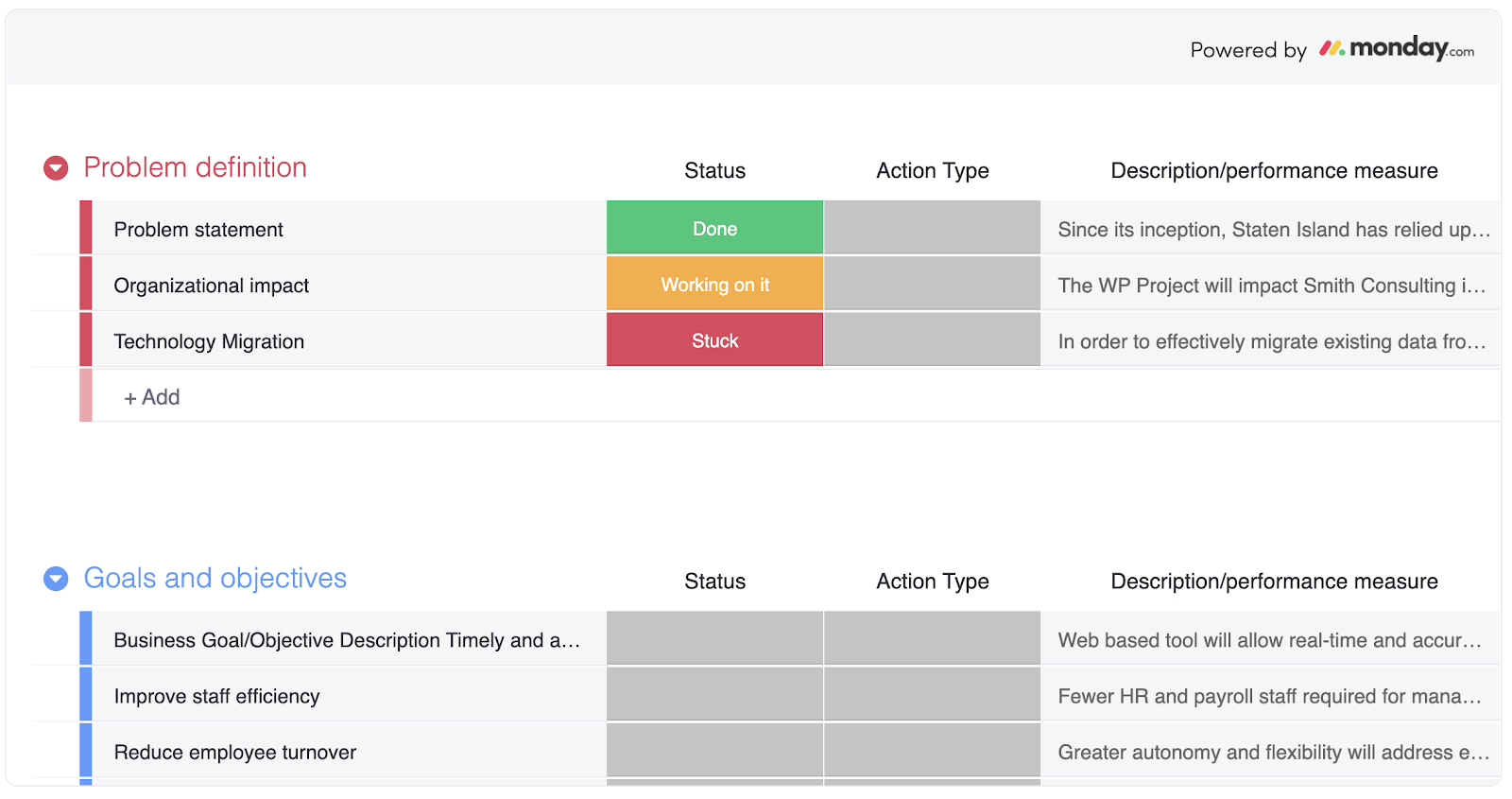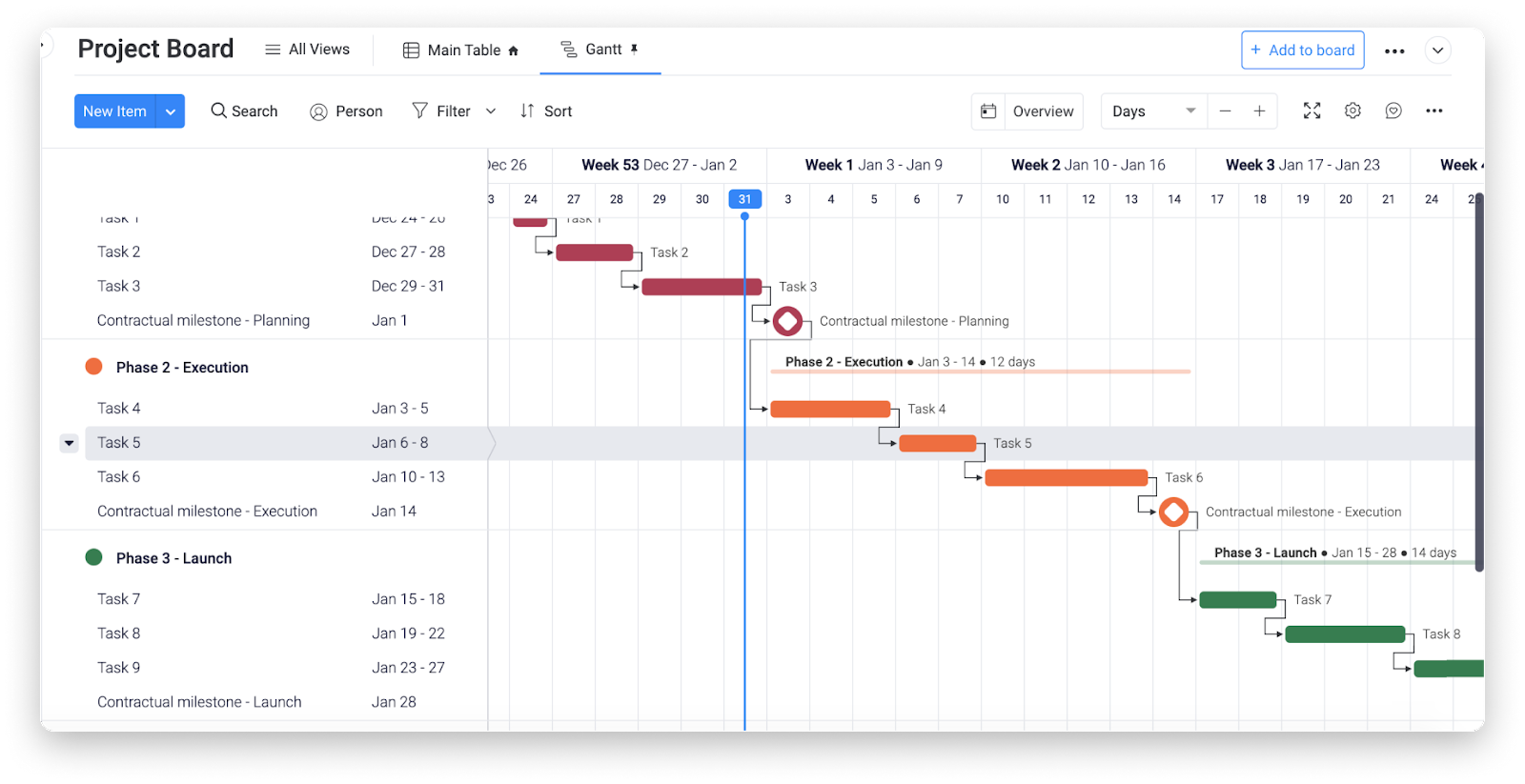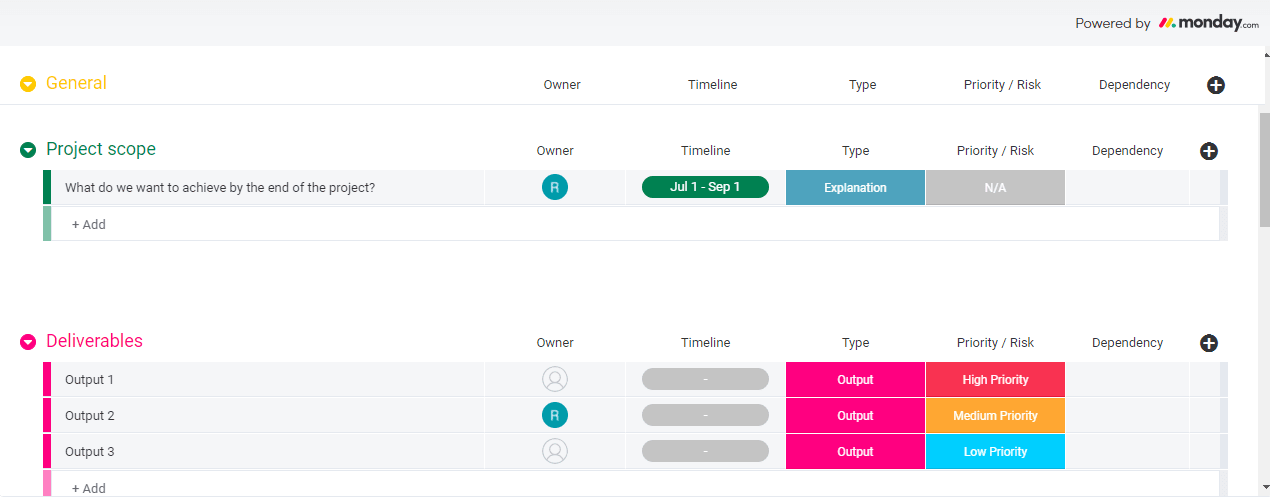Scope of work — one of the many things that could stand between you and a lot of potential double work with your client.
Writing a scope of work for a client can be time-consuming and requires a lot of research, but it contains valuable information that project managers swear by to keep their projects on track and within budget.
In this article, we’ll break down scope of work, best practices for managing it in complex projects, and useful features for avoiding scope creep on monday.com.
What is scope of work?
Scope of work describes a documented, deep dive into the details of the expected project work and make it more clearly defined. It involves setting specific limits and boundaries to your project.
Project managers and teams will clearly define the tasks, goals, deliverables, deadlines, and expectations for all parties involved. More importantly, it also defines what’s not part of the project.
You can find the scope in a project’s statement of work (SOW).
What is a statement of work?
A statement of work or SOW is a document that outlines the groundwork for a project. It’s the agreement between you and the client, agency, service provider, or subcontractor that clearly defines specifics like task details, payment terms, expected outcomes, and deliverables.
A statement of work is written during the initiating phase of the project life cycle. The initiating phase is the period where the project idea is described, reviewed, and eventually cleared to move forward. Scope of work is a section within the SOW. The statement of work refers to the document itself.
Why is scope of work important?
A well-defined scope of work saves you time and money. More importantly, it saves you from unnecessary headaches.
The scope of work gives you the power to say “no” within reason.
Asks and additional initiatives that come up throughout the project lifecycle can be evaluated and prioritized more clearly — either it’s in the scope or not, and if your responsibilities begin to stray outside of what was originally agreed upon, the scope of work gives you a document to refer back to.
What is scope creep?
If you’re remotely familiar with scope of work, then you’ve probably heard the term “scope creep.” Scope creep is often referred to as “feature creep” or “requirement creep.” Ultimately, scope creep refers to a project’s tendency to increase requirements throughout its lifecycle.

If a project begins with five deliverables and now your stakeholders or clients want eight, or the must-have features for the product jump from three to five, you’re experiencing scope creep. It’s more common than you’d think. All too often, you’ll have a client ring you up and say, “hey can we just add in one small thing…”
The customer’s needs often change, and so do their priorities, which is often the catalyst for changing the project’s scope or requirements. However, scope creep can also occur from not accurately defining scope enough. However it happens, scope creep can cause a project to get off track and go over budget.
Who defines and writes the scope of work?
A wide array of companies use scope of work— from software and web design companies to construction companies and wedding contractors. The list goes on and on, which means who ultimately ends up writing them will vary. In a lot of these industries, you’ll have a traditional project manager who is driving the desired outcomes and is familiar with writing up the scope of work document.
In other cases, it could be a project sponsor, a salesperson, or someone else writing the scope. In some cases, the entire SOW, including the scope of work, is written by the client. In those situations, the scope of work may have multiple authors and will often include input from people like the project manager, third-party contractors, and the Chief Information Officer if it’s a software or IT project.
Writing an SOW can feel a little daunting, but if you use your available resources, engage stakeholders, and consult with subject matter experts, you’ll find it’s easier than it seems.
Arguably the most important thing you can do if you’re writing a scope of work is to consider the nuanced differences between each project. If you cut corners, you may end up regretting it later.How do you write a simple scope of work — and prevent scope creep?
There’s no single way to write out the scope of work document, but there are some general guidelines and considerations to review. As this process involves a high level of detail, you’ll want to take your time to ensure maximum clarity from beginning to end.
1. Adopt a scope creep avoidance mindset
The scope of work needs to be detailed, but not unreasonably so.If it’s extremely detailed, you may find yourself doing unnecessary work and artificially constraining your project just because you wrote down that you would.
But a scope that’s too broad, generic, or vague leaves room for interpretation, which could mean trouble later in the project. Ultimately, you have to find a balance to keep your client satisfied and your project profitable and free of roadblocks.
2. Begin with the end by clearly defining objectives
Project objectives reiterate the final goal of the project. It’s the “why” behind the project and is ideally something realistic and valuable to the client or end-user.
The objective should answer the question, “what do you hope to achieve with this project?”

Objectives typically define deliverables in detail, so there’s no confusion between you and the client or stakeholder. Deliverables are either accepted or rejected.
The greater the detail, the better when deciding upon deliverables. If it’s a product, specify the dimensions, weight, features, etc. monday.com’s Project Plan Template is a game-changer when writing out objectives since it helps clearly define the problem, set clear descriptions of goals, and enables you to visualize those goals.
The objective likely won’t go into detail over each individual task that creates the deliverables. That comes in the next section.
3. Clearly define the project steps
Here’s where the bulk of the work comes in. You know the objectives and what the deliverables look like; now, you have to figure out what tasks lead up to delivering on your promise.
Mastering task management is the first step of executing a successful project, but selecting the right Work OS can bring your team to the next level by allowing you to run all of your work in one place.
To start, your main focus is creating an exhaustive task list of all the things you’d need to accomplish to deliver the project successfully. Since this section isn’t about deliverables, it’s best to focus on actions like “redesigning a web page” or “creating a test environment.” Ideally, you’d document these tasks in a logical order that takes dependencies into account.
You don’t need to get into the nitty-gritty day-to-day work — just capture all the big pieces of the puzzle. Finally, you’ll want to include a section on what’s out of scope to make it clear to everyone what’s not included in the price.
If there are adjacent tasks that other parties are responsible for or a typical task list this project isn’t taking on, you’ll want to call that out here so that nobody’s confused.
You may want to consider using a work breakdown structure.
4. Create a realistic schedule
You know where you’re going and what you’re doing. Now it’s time to decide how long it will take.
If the project is large and complex, that may mean setting multiple project milestones. Perhaps each milestone delivers a subset of the final deliverable. In that case, you’ll want to ensure those milestones get highlighted somewhere.
monday.com has an excellent Gantt chart feature to help you visualize your schedule and identify key milestones.

Ideally, you’d factor in some buffer room to prepare for obstacles or risk along the way. Underpromise and overdeliver is usually an excellent way to set your deliverable schedule and keep your client happy.
5. Settle on a final budget
Once you know the deliverable, the individual steps to deliver it, and how long it will take, you should have a decent grasp of what resources you’ll need. Raw materials, technology, and human resources are all a factor. Don’t forget to include any subcontractors you may need to hire.
Now you need to settle on a budget and payment terms. If there are project milestones, it’s wise to get payments at each milestone. Perhaps a deposit down and another payment upon completion.
If there are fixed fees or variable fees included, be sure to document that now so there’s no dispute later.
The same thing goes for how payments are made. Will there be ACH, wire transfer, or physical checks? What happens if a deadline is missed or the scope increases? Again, the greater detail, the smoother things will go.
A cost breakdown structure can help for this task.
6. Shake hands and get to work
The final piece of the scope of the work puzzle is getting the agreement of all parties involved. Review the scope of work together and ensure everyone knows the criteria for “acceptable” deliverables.
Now all you have to do is get the client to sign off. Since it’s an enforceable contract, you should technically both sign it. Starting a project without a signature is a recipe for disaster that’ll likely bite you later by costing you more money or resources than initially planned. It could even land you in court to settle disputes.
Once that’s all out of the way, all that’s left is getting down to business!
Scope of work essentials best practices
Best practices will vary by industry, but there are a few tried and true methods that are applicable to most.
Include details for post-project involvement
An often-overlooked section in the scope of work is clearly defining support after the project is completed. If there’s a warranty period, maintenance agreement, or technical support involved, it’s good to document that upfront. There’ll be no shortage of client questions after the fact, and hopefully more projects you can work on together. That’s why it’s critical to take the extra time here and make sure you’re on the same page.
Keep a copy on file
If your client isn’t familiar with scope of work documents and is uneasy about signing one, it may be wise to keep a copy of SOW documents from past projects around to provide as an example. It can quell the uneasiness and give you a frame of reference for agreeing to project terms.
Prioritize visual and communicative clarity
Another good tip is to share the SOW with your team members before signing, so everyone agrees. They’re the ones doing the bulk of the work, so if there are any concerns, it’s wise to address them early. Finally, be sure to include visual aids such as drawings, mockups, graphs, and photos to settle any possible ambiguity before you begin.
monday.com makes managing the scope of work easy
Projects are hard, and we here at monday.com want to change that. Our platform makes it easy to customize and visualize the intricacies of your work—from day-to-day work to big picture projects.
That means you can focus less on keeping the project organized and more on the actual work that delivers outcomes.

The easiest way to kick off a project with monday.com is a proposal board. On it, you’ll work on defining problems, setting action types, measuring performance, and setting milestones.
Everything is color-coded and customized to how you do things, so you’re not stuck with a rigid framework to work around. monday.com supports your work with beautiful visuals like our Gantt Chart, Timeline, and Schedule Views.
Each provides its own unique perspective on what the team has accomplished and what’s next on the agenda. Combine that with our stunning dashboards, and you’re sure to wow your client and keep your team engaged throughout the process.
Get started with monday.com for SOW documentation
In a world that’s rapidly changing and becoming more demanding by the day, the project scope is more important than ever.
Without it, your timeframe for completion is less predictable, your project are subject to scope change, and you can virtually guarantee the entire project will cost more than you originally planned.
The solution is simple. Write up a detailed scope of work document and leverage the power of monday.com to ensure your team sticks to the project scope from beginning to end.
To help you get started, give our Project Proposal Template a spin.

